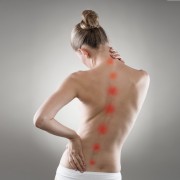Scoliosis: check your curves early
What do Elizabeth Taylor, Renee Russo, Isabella Rossellini and Linda Blair all have in common? Aside from the obvious fact that they are popular and gorgeous celebrities, these women suffer from a back problem called scoliosis

Scoliosis is a medical condition that is characterized by the presence of curvatures and deformities in the spine. Unlike poor posture, these curves can not be corrected by simply learning to stand up straight.
Scoliosis affects a small percentage of the population, or approximately two percent. However, scoliosis runs in families. If someone in the family has scoliosis, the likelihood of an incidence is approximately 20 percent. Scoliosis in skeletally immature individuals is classified by age: infantile (0 to 3 years); juvenile (3 to 10 years) and adolescent (over 11 years, or from onset of puberty until skeletal maturity). In addition, scoliosis is classified by etiology: congenital, idiopathic or neuro-muscular.
Congenital scoliosis results from embryological malformation of one or more vertebrae and may occur in any location of the spine. This is due to a problem with the formation of vertebrae or fused ribs during prenatal development. The vertebral anomalies cause curvature and other deformities of the spine and lead to differential growth. This means that one area of the spinal column lengthens at a slower rate than the remainder. Because these anomalies are present at birth, congenital scoliosis is usually detected at a younger age than is idiopathic scoliosis.
Idiopathic scoliosis refers to a spinal curve for which there is no discernible cause and it typically occurs in children and adolescents who are otherwise healthy. It is of unknown cause and appears in a previously straight spine.
Neuro-muscular scoliosis is caused by problems such as poor muscle control or muscular weakness or paralysis due to diseases such as cerebral palsy, muscular dystrophy, spina bifida and polio. It encompasses scoliotic spine deformities that are secondary to neurologic or muscular diseases. Etiologies of this type of scoliosis include cerebral palsy, spinal cord trauma, muscular dystrophy, spinal muscular atrophy and myelomeningocele. Spinal deformities that result from neuro-muscular etiologies generally progress more rapidly than idiopathic scoliosis and are more difficult to manage non-surgically.
Signs of Scoliosis

There are several “warning signs” to determine if you or someone you love has scoliosis. If you notice any one or more of these signs, you should schedule an exam with a doctor:
- Shoulders are different heights; one shoulder blade is more prominent than the other.
- The head is not centered directly above the pelvis.
- Appearance of a raised, prominent hip.
- Rib cages are at different heights.
- Changes in look or texture of skin overlying the spine like dimples, hairy patches, color changes.
- Uneven waist.
- Leaning of entire body to one side.
If someone is suspected with scoliosis, it is usually confirmed with an x-ray, spinal radio-graph, CT scan, MRI or bone scan of the spine. The curve is then measured by the Cobb Method and is discussed in terms of degrees. The Cobb method has several advantages over other methods, including the fact that it is more likely to be consistent even when the patient is measured by several different examiners. An alternative system, known as the Risser-Ferguson method, is used far less commonly. Generally, a curve is considered significant if it is greater than 25 to 30 degrees. Curves exceeding 45 to 50 degrees are considered severe and often require more aggressive treatment.
The traditional medical management of scoliosis is determined by the severity of the curvature, skeletal maturity and likelihood of progression. The conventional options are initially through observation, followed by bracing and surgery. Most cases of adolescent idiopathic scoliosis that are less than 20 degrees require no treatment but should be checked every 6 months. As curves get worse which is above 25 to 30 degrees, bracing is usually recommended to help slow the progression of the curve. Curves that are greater than 40 degrees usually require surgery because curves this large have a high risk of getting worse even after bone growth stops.
Scoliosis is a common problem that usually requires only observation with repeated examination in the growing years. Still, early detection is important to make sure the curve does not progress. In the relatively small percentage of scoliosis that need medical intervention, advances in modern orthopedic techniques have made scoliosis a highly manageable condition.
Related Articles
When should I see a doctor for hip pain?
Dr Andrew Dutton shares what to expect when seeing the doctor for hip pain
Read moreWhat if your child has joint pain?
Arthritis can significantly affect the life of young children if it is not treated early, according to Dr Cham Weng Tarng from Sunway Medical Centre
Read moreWhat causes back pain?
Dr Benjamin Tow discusses the most common causes of acute and chronic back pain
Read moreLatest Articles
Medical Care
Achieving Swift Recovery: Enhanced Recovery (ERAS) Direct Anterior Approach Total Hip Replacement
Consider total hip replacement with Alps Orthopaedic Centre's ERAS Direct Anterior Approach for faster recovery and reduced hospital stays. Learn about Dr. Jerry Chen's expertise in Singapore.
Read moreMedical Care
Enhanced Recovery (ERAS) Total Knee Replacement
Discover how Alps Orthopaedic Centre's Enhanced Recovery After Surgery (ERAS) approach transforms total knee replacement into a day surgery, offering faster recovery, less pain, and reduced hospital bills. Learn about Dr. Jerry Chen's expertise and schedule your appointment in Singapore.
Read moreMedical Care
Clinical Exercise Physiologist (CEP): The Emerging of Exercise is Medicine
How Exercising can be a Medicine
Read more